Medical imaging has been a pivotal element in modern healthcare, allowing healthcare professionals to visualize and diagnose a wide range of medical conditions with precision and accuracy.
The evolution of medical imaging, from the discovery of X-rays to advanced technologies like 3D printing, has witnessed remarkable advancements that have not only improved patient care but also expanded our understanding of the human body.


Historical Progress of Medical Imaging
The roots of medical imaging can be traced back to the late 19th century when Wilhelm Conrad Roentgen discovered X-rays in 1895. This groundbreaking discovery paved the way for radiography, commonly known as X-ray imaging, which revolutionized medicine by enabling non-invasive visualization of the internal structures of the body.
In the early 20th century, the evolution of X-ray technology continued, leading to the development of fluoroscopy, which allows real-time visualization of moving internal structures. Ultrasound, another essential medical imaging modality, made its mark in the mid-20th century, using high-frequency sound waves to create images of the body’s interior, particularly during prenatal care.
The 1970s marked the arrival of computed tomography (CT) scanning, which combines X-ray imaging with computer processing to produce detailed cross-sectional images. This was a significant advancement that enhanced diagnostic capabilities.
In the 1980s, magnetic resonance imaging (MRI) emerged as a powerful imaging modality. It uses strong magnetic fields and radio waves to generate detailed images of internal structures, proving invaluable in imaging the brain, spinal cord, and musculoskeletal system.
As these foundational developments took place, medical imaging continued to evolve, leading to the introduction of innovative technologies that further reshaped patient care and medical research.
Innovations in Medical Imaging
- Digital Radiography (DR): Digital radiography replaces traditional film-based radiography with digital detectors. This technology enables immediate image viewing and electronic storage, enhancing convenience for healthcare providers and reducing patient radiation exposure.
- Mammography and 3D Breast Tomosynthesis: Mammography has been crucial for breast cancer screening. The introduction of 3D breast tomosynthesis has improved breast cancer detection, offering a more comprehensive view of breast tissue.
- Positron Emission Tomography (PET): PET imaging, a nuclear medicine technique, provides insights into the body’s metabolic processes. It is valuable in oncology, neurology, and cardiology, allowing for tumor detection, disease tracking, and cardiac function assessment.
- Interventional Radiology: This subspecialty uses various imaging modalities, including X-rays, CT scans, and ultrasound, to guide minimally invasive procedures. It has revolutionized surgery by reducing risks and recovery times.
- Functional MRI (fMRI): Functional MRI captures dynamic images of the brain, depicting changes in blood flow and oxygenation. It is critical in cognitive neuroscience and neurological disorder diagnosis.
- Cone Beam CT (CBCT): Cone beam computed tomography offers high-resolution 3D images with minimal radiation exposure. It is commonly used in dentistry for oral and maxillofacial imaging.
- 3D and 4D Ultrasound: Traditional ultrasound produces 2D images, but 3D and 4D ultrasound technologies provide 3D images and real-time videos. They enhance prenatal care by offering a more comprehensive view of fetal anatomy and movements.
- Magnetic Resonance Angiography (MRA): MRA, a specialized MRI technique, focuses on imaging blood vessels. It is valuable for diagnosing vascular conditions without invasive procedures.
- Dual-Energy CT (DECT): Dual-energy CT captures images at two X-ray energy levels, improving tissue characterization and the detection and diagnosis of various medical conditions.
- Artificial Intelligence (AI) in Medical Imaging: AI has evolved medical imaging by analyzing large datasets of medical images to identify patterns, anomalies, and potential diagnoses, aiding in diagnosis, image segmentation, and disease progression prediction.


3D Printing in Medical Imaging
The evolution of medical imaging and 3D printing has given rise to anatomical models, surgical guides, patient-specific implants, and prosthetics. The applications include:
- Anatomical Models: 3D printing creates highly accurate anatomical models based on patient-specific imaging data, enhancing preoperative planning and education.
- Surgical Guides: Customized surgical guides improve accuracy during complex procedures, particularly in orthopedic surgeries.
- Patient-Specific Implants: Custom implants, such as cranial implants and dental prosthetics, match the patient’s unique anatomy, resulting in better fit and improved outcomes.
- Prosthetics and Orthotics: 3D printing has revolutionized prosthetic limbs and orthotic devices by offering customized, comfortable, and highly mobile solutions.
- Drug Delivery Systems: 3D printing creates personalized drug delivery systems, offering precise dosages and release rates tailored to individual patient needs.
- Tissue Engineering: Although still experimental, 3D printing is explored for tissue engineering, with the potential to revolutionize regenerative medicine and organ transplantation.
Challenges and Considerations in Medical Imaging
Despite the progress, medical imaging presents challenges and considerations, including:
- Radiation Exposure: X-ray and CT imaging involve ionizing radiation, which can pose health risks with repeated exposure. Reducing radiation doses while maintaining image quality is an ongoing challenge.
- Cost: High-end medical imaging equipment and AI integration can be costly, limiting access, particularly in low-resource settings.
- Privacy and Security: Ensuring patient data privacy is critical as digital imaging and AI usage expand. Securing medical images and patient information is paramount.
- Interoperability: Seamless image and patient data sharing across healthcare systems can be challenging. Interoperability issues may disrupt the continuity of care.
- Training and Education: Proficiency in advanced imaging and AI interpretation is essential. Effective training and ongoing education are crucial for healthcare professionals.
- Ethical Concerns: The use of AI in medical imaging raises ethical considerations regarding accountability for AI-generated diagnoses and the potential for algorithmic bias. Developing ethical guidelines is essential.
- Regulatory Compliance: Staying compliant with evolving regulations is complex, as medical imaging technologies are subject to rigorous oversight to ensure patient safety and device performance.


The Future of Medical Imaging
The future evolution of medical imaging holds promise, with ongoing innovations and technological advancements:
- AI Integration: AI will continue to play a central role, enhancing diagnostic accuracy and enabling predictive analytics for disease prevention.
- Telemedicine and Remote Imaging: The adoption of telemedicine and remote imaging will persist, increasing healthcare accessibility, especially in underserved regions.
- Quantitative Imaging: Precise measurements and quantification of tissue properties will become increasingly important for disease characterization, treatment planning, and monitoring.
- Advanced Imaging Modalities: Emerging modalities, such as photoacoustic and molecular imaging, will expand diagnostic capabilities and provide deeper insights into disease processes.
- 3D Printing and Bioprinting: The growth of 3D printing in healthcare will continue, with applications in regenerative medicine and personalized implants and prosthetics.
- Global Collaboration: Collaborative research and data sharing will lead to a more comprehensive understanding of diseases and improved diagnostic and treatment options.
- Precision Medicine: Medical imaging will play a pivotal role in advancing precision medicine, enabling tailored treatments based on individual patient characteristics.


The journey of medical imaging, from the discovery of X-rays to advanced technologies like 3D printing, has significantly impacted patient care and medical research. These innovations have improved diagnostic accuracy, personalized patient care, and the overall understanding of the human body.
While medical imaging brings numerous benefits, it also poses challenges related to radiation exposure, cost, privacy, and ethical considerations. Addressing these challenges is essential to harness the full potential of medical imaging. The future of medical imaging is bright, with AI integration, telemedicine, 3D printing, and global collaboration on the horizon.
These advancements will further improve patient care, expand diagnostic capabilities, and contribute to the growth of precision medicine. In a rapidly evolving healthcare landscape, medical imaging remains a cornerstone of modern medicine, enabling healthcare providers to explore the human body’s intricacies and provide the best possible care to patients.































I just could not depart your web site prior to suggesting that I really loved the usual info an individual supply in your visitors Is gonna be back regularly to check up on new posts
I always leave this blog feeling inspired and motivated to make positive changes in my life Thank you for being a constant source of encouragement
Thank you a lot for giving everyone an exceptionally terrific chance to read from this website. It’s usually very terrific and jam-packed with fun for me and my office peers to search your web site at the least three times in a week to study the fresh guides you have. And of course, we’re usually satisfied with all the astonishing tips and hints you serve. Certain 2 points in this post are really the most efficient we have ever had.